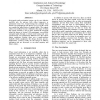Free Online Productivity Tools
i2Speak
i2Symbol
i2OCR
iTex2Img
iWeb2Print
iWeb2Shot
i2Type
iPdf2Split
iPdf2Merge
i2Bopomofo
i2Arabic
i2Style
i2Image
i2PDF
iLatex2Rtf
Sci2ools
ICAD
2004
2004
Auditory Navigation Performance is Affected by Waypoint Capture Radius
Non-speech audio navigation systems can be very effective mobility aids for persons with either temporary or permanent vision loss. Sound design has certainly been shown to be important in such devices [e.g. 1]. In this study we consider the added factor of capture radius. The capture radius of an auditory beacon is defined as the range at which the system considers a user to have reached the waypoint where the beacon is located. 108 participants successfully navigated paths through a virtual world using only nonspeech beacon cues. Performance differed across the capture radius conditions. Further, there was a speed-accuracy tradeoff, which complicates the design decision process. Implications of these results for the design of auditory navigation aids are discussed, as are other ongoing and future studies.
Capture Radius | Capture Radius Conditions | Effective Mobility Aids | Emerging Technology | ICAD 2004 |
| Added | 31 Oct 2010 |
| Updated | 31 Oct 2010 |
| Type | Conference |
| Year | 2004 |
| Where | ICAD |
| Authors | Bruce N. Walker, Jeff Lindsay |
Comments (0)

